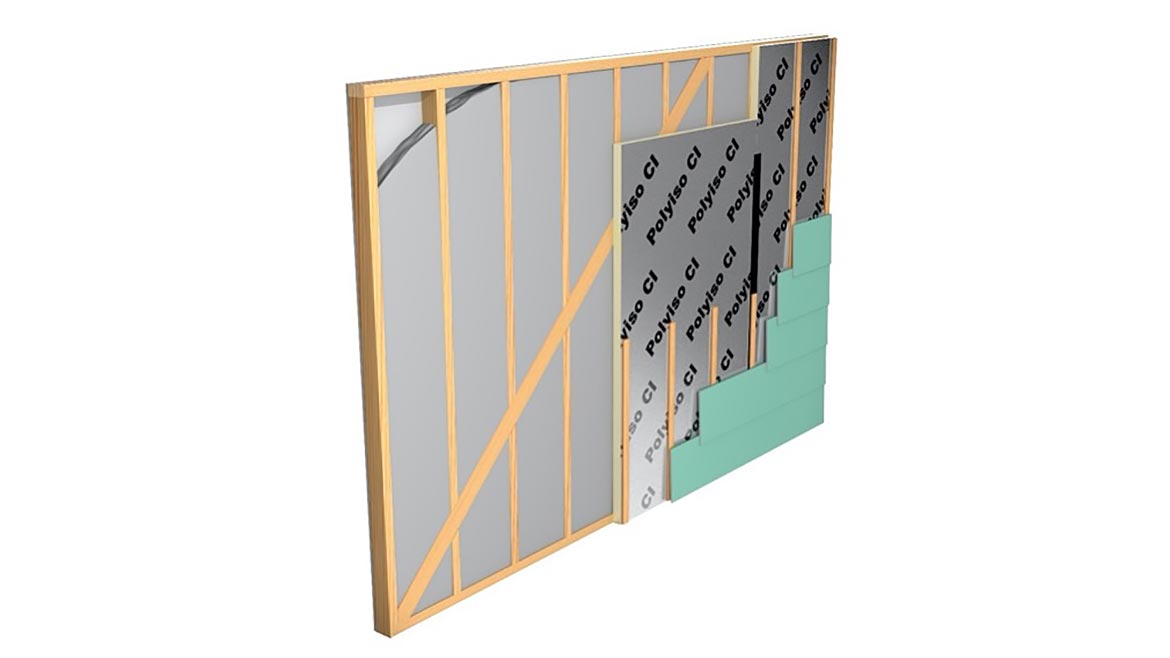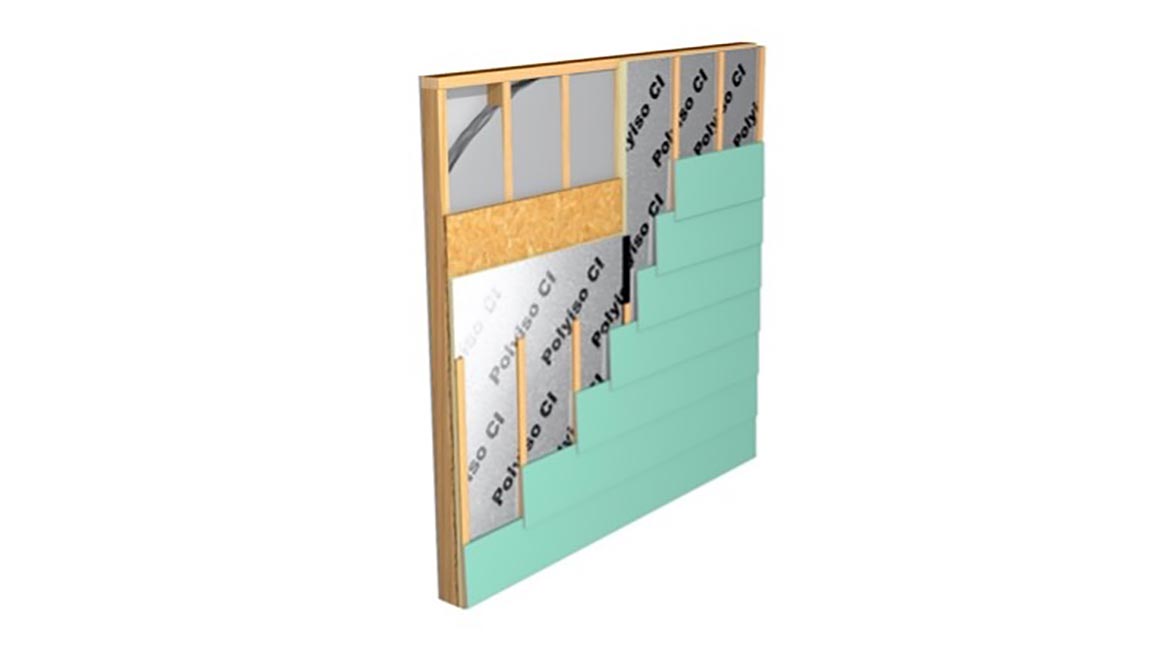Escalating construction costs are a significant concern this year with new home starts reaching all-time highs and sustained interest in renovations spurred by owners spending more time at home or ready to proceed with projects deferred due to the pandemic. Increased demand and supply-side constraints have made lumber prices especially volatile, according to the National Association of Home Builders, which estimates that the unprecedented spike in lumber prices has added nearly $36,000 to the average price of a new single-family home in 2021.
Builders are looking for alternative products and construction methods to reduce their reliance on wood and help mitigate material costs and supply-chain disruptions for wood-framed homes and other construction.
Conventional wood frame structures must be properly braced to resist lateral loads. Many recognize that a wall system using polyisocyanurate continuous insulation can serve the same functions as wood while also adding to a wall’s insulating value (R-value), and providing a water resistive barrier and air barrier functionality. This can help builders achieve energy-code compliance while also decreasing the impact of lumber shortages on their projects. While it may seem like a new approach, using Polyiso CI in place of OSB has been common practice, but it is often overlooked in favor of traditional structural sheathing options like OSB and plywood.
Also consider that a typical wall, with insulation only between wood studs, leaves more than 25 percent of the wall uninsulated due to the exposed framing, which creates thermal bridges. The use of Polyiso CI across the entire wall creates an insulated envelope that increases the thermal performance of the building and can serve as water resistive and air barriers—which wood structural panels cannot provide.
When in Doubt, Consult the Codes
Polyiso CI is not a structural bracing material. Therefore, wall systems with Polyiso CI must be separately braced to resist lateral loads resulting from wind and seismic loads. Bracing is required by the model building codes, and when used with Polyiso CI, can reduce a builder’s reliance on wood structural sheathing.
When considering a wall bracing plan, it makes sense to first consult your local building code regulations. Polyiso CI manufacturers may offer products that integrate a structural component with the insulation that can be used to meet bracing requirements in the model building codes. The wall bracing requirements are described in the following sections of the model building codes:
- 2018 International Residential Code for One- and Two-Family Dwellings, Chapter 6, Section R602.10 Wall Bracing.
- 2015 National Building Code of Canada, Chapter 9, Sub-section 9.23.13, Bracing to Resist Lateral Loads Due to Wind and Earthquake.
- Different bracing methods can be used to create code compliant Polyiso CI walls.
1. Let-in wood bracing and Polyiso CI:
1-inch by 4-inch let-in diagonal wood bracing may be used to provide resistance against lateral loads. Where used, let-in bracing is installed at the building corners and at specified intervals along the length of walls as required by the local building code. (See Figure 1).

Figure 1. Diagonal wood bracing used to provide resistance against lateral loads.
2. Continuous Wood Structural Panel:
Some builders choose to brace walls with plywood, OSB, structural grade fiberboard exterior sheathing, or other proprietary sheathing products. Required nailing schedules are found in the model building codes and in manufacturer installation instructions. When using wood structural panels (plywood or OSB) as bracing, place thinner Polyiso CI boards over the structural sheathing and thicker Polyiso CI boards on the remaining opaque wall sections to achieve a consistent total thickness along the length of the wall. This technique will allow the installation of a highly energy-efficient building envelope using Polyiso CI. (See Figure 2).

Figure 2. Wood structural panels such as plywood, OSB, or structural grade fiberboard exterior sheathing used for bracing.
3. Structural Foam Sheathing:
Many Polyiso CI manufacturers offer structural foam sheathing products that can be used for bracing walls. Utilizing these proprietary Polyiso CI products provides a consistent layer of insulating material across the exterior building envelope. This combination provides structural integrity and appropriate thermal resistance in the wall system, and can decrease labor costs associated with installing multiple products.
4. Steel Framing:
The increasing popularity of steel framing in residential construction has prompted the development of new construction techniques. The proper method for bracing steel framing is discussed in detail in AISI 230: Standard for Cold-Formed Steel Framing- Prescriptive Method for One- and Two-Family Dwellings.
At a time when wood products are in great demand and the supply chain is unreliable, determined builders are exploring alternatives that can help them deliver building projects on time and at a reasonable cost, without compromising on quality or energy efficiency. Polyiso CI offers a widely available solution that can easily be adapted to help reduce a project’s lumber needs while also meeting building code requirements for structural integrity and energy efficiency. For more information on Polyiso CI and its effective use in residential construction, visit polyiso.org.
Continuous Insulation to Eliminate Thermal Bridging and Improve Overall Home Performance
In addition to reducing lumber requirements on a project, the use of polyisocyanurate continuous insulation (Polyiso CI) creates the opportunity to eliminate thermal bridging—the loss of heat at uninsulated joints and studs. Polyiso CI achieves a higher effective R-value with minimal material thickness meaning homeowners can have a more energy-efficient home without sacrificing usable space. Polyiso CI performs several critical functions in high-performance residential wall construction:
- Thermal Insulation: Insulating the entire opaque surface of framed walls with Polyiso CI keeps energy losses and gains to a minimum. The continuous insulation plane reduces thermal bridges that are responsible for significant energy losses in typical home construction. Cavity insulation (installed between framing members) may not be required when using Polyiso CI depending on the required opaque wall assembly U-factor, climate zone, and thickness of product used. Polyiso CI manufacturer installation instructions should be followed to ensure proper attachment of the insulation to the framing prior to the installation of the cladding system.
- Water Resistive Barrier: Many Polyiso CI products with taped or sealed joints are classified as water resistive barriers that provide a drainage plane and a secondary line of defense against rainwater intrusion behind the cladding. The joints between adjacent Polyiso CI boards should be taped or sealed with an approved product in accordance with manufacturer installation instructions. Sealing along the top and bottom plates of the wall, around all openings, and integrating window and door flashings is critical when Polyiso CI is installed as part a WRB assembly. Consult manufacturer installation instructions for guidance on WRB design, details, and accessories.
- Air Barrier: Polyiso CI is considered an air barrier material when taped or sealed appropriately along the exterior joints. The model building codes list Polyiso CI as an air barrier material when installed at a minimum 1/2 inch thickness. The use of Polyiso CI as part of an air barrier assembly reduces air infiltration and exfiltration.
As part of the air barrier system, Polyiso CI must be integrated with other materials to form a continuous air barrier system within the building envelope. See the manufacturer installation instructions for details on how to seal panel joints, penetrations, and interfaces with other building envelope materials. Penetrations for plumbing, electrical, air conditioning, dryer vents, and other openings should be sealed with a sealant appropriate for the application to ensure long-term performance.
Note: Attention should be paid to sealing the inside and outside corners and tying-in the air barrier at the roof-to-wall and wall-to-foundation transitions. Properly taped or sealed Polyiso CI can be a building code compliant WRB or air barrier material. Polyiso CI can eliminate material and labor costs associated with the installation of a separate WRB or air barrier products such as house wraps.
- Vapor Retarder: In heating or mixed climates, a continuous vapor retarder is typically installed on the interior side of the framed wall to reduce water vapor transfer from the occupied space and thus reduce the risk for condensation in the wall system. An interior vapor retarder may not be necessary when a proper amount of Polyiso CI is installed on the exterior side of the wall. Good construction practice dictates that penetrations at electrical outlets should be sealed to provide moisture and air flow control. Always consult local building codes for vapor retarder requirements.
- Cladding: Any code approved cladding system may be used over Polyiso CI. Each cladding system typically requires specific installation details, attachment methods, and accessories. The cladding system manufacturer installation instructions should be followed as well as the requirements in Section R703.15 of the International Residential Code for One- and Two-Family Dwellings (IRC). The installer should exercise caution to prevent damage to Polyiso CI during installation. In some wood siding applications, furring strips may be required over Polyiso CI to provide ventilation and drainage prior to the installation of the wood siding.




